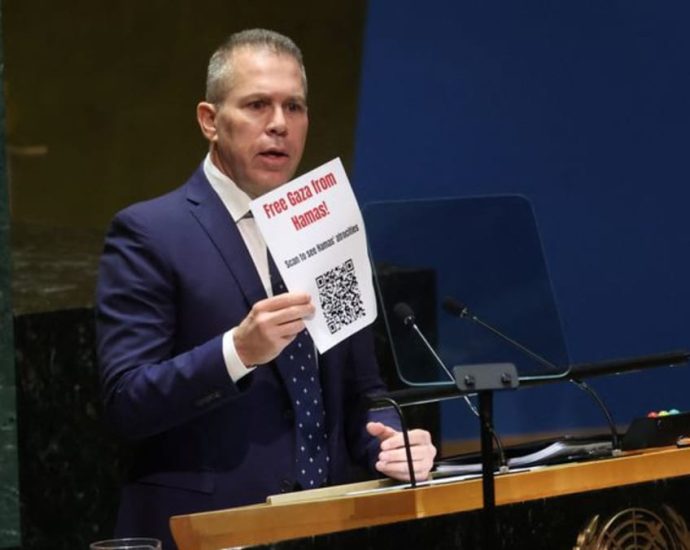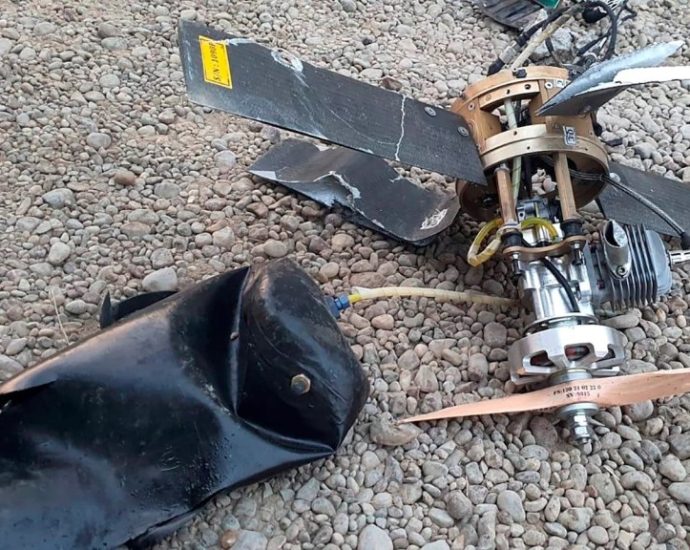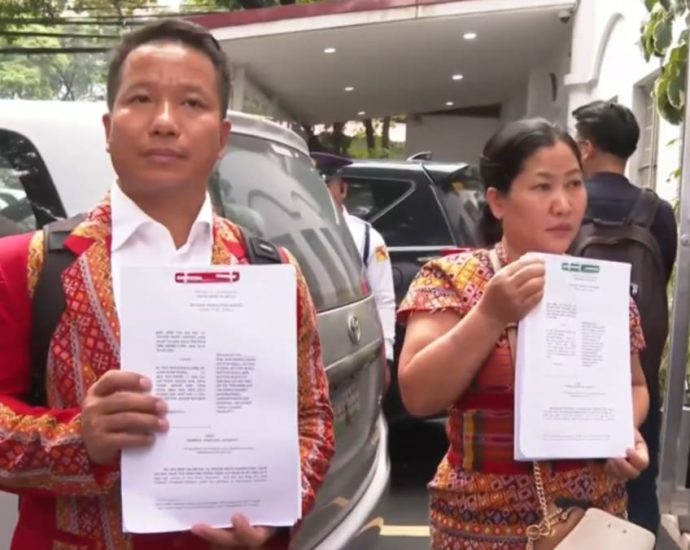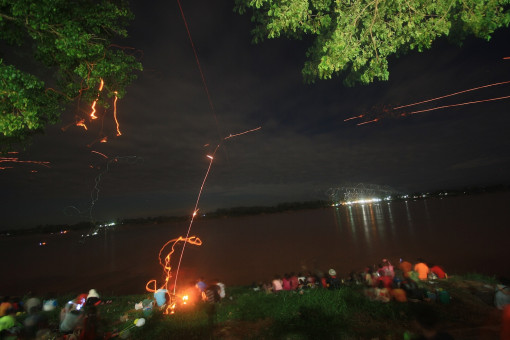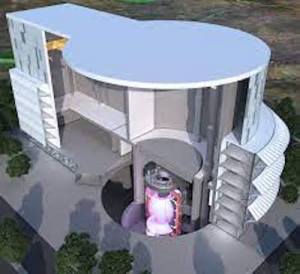US-China tensions will slow global chip industry, TSMC founder says
NEW YORK: The founder of the world’s biggest chipmaker, Morris Chang, said on Thursday (Oct 26) that increasing tensions over technology between the United States and China will slow down the global chip industry. Chang, who founded Taiwan Semiconductor Manufacturing Co in the late 1980s, made the remarks at anContinue Reading
Israel’s UN envoy plays gruesome Hamas attack video of Thai victim
UNITED NATIONS: Israel’s United Nations envoy showed the 193-member General Assembly a brief video on Thursday (Oct 26) that he said showed a Hamas fighter trying to decapitate a man with a garden tool during the Palestinian militants’ Oct 7 attack on Israel. Ambassador Gilad Erdan told diplomats the victimContinue Reading
US Iraq and Syria bases lack effective air defenses
For years I have complained that vulnerable American bases in Iraq and Syria lacked adequate air defenses. Bottom line: they still do.
It is reported that the Biden administration asked for a “pause” in the upcoming Israeli land attack on Gaza so the Pentagon could rush air defenses to the Middle East.
In the past week 21 US personnel received minor injuries due to drone attacks at Al Assad Airbase, Iraq, and Al-Tanf Garrison, Syria.
There have been at least 14 attacks on these bases in the past week, perhaps more than 20. The numbers vary as the Pentagon slowly confesses what transpired.
The strikes against US bases have been carried out either by Iranian-supplied drones operated by Iranian proxy militias or by Iranian-supplied rockets operated by the same Iranian proxy militias.
There is no doubt about the source of the attacks. But the administration does not show any interest in challenging Iran.

US bases have very limited protection, made worse by the fact that the US does not pursue the pro-Iranian militias firing these weapons at American personnel.
US troops primarily rely on the C-RAM. C-RAM is a land-adaptation of the US Navy’s Phalanx gun system. The rapid-fire but short-range Phalanx system has never stopped any attack on a naval ship, and things are not much different when it comes to knocking out drones or rockets.
C-RAM, like Phalanx, has problems at night because it primarily relies on visual recognition of incoming threats. Iranian drones are made of plastic or other non-reflective material, so they don’t have much, if any radar signature, and also are hard to see, especially at night or in low light conditions.
Even so, if the Pentagon story is right, some rockets and drones have been shot down, probably by C-RAM. Luckily the rockets being used are highly inaccurate and can be tracked by radar, although hitting them is another matter.
But the big story is that the US has not provided effective weapons to protect US bases.
They could have done so, at least in part, had they heeded warnings and really cared about our troops in the field. Obviously our soldiers were a low priority.
The US bought two batteries of Israel’s Iron Dome system and have had them for a number of years, allegedly studying how to use them. For a while they shipped Iron Dome to Guam, for no apparent reason because the threat to Guam from China is from heavy missiles. Iron Dome is designed to go after terrorist weapons, not heavy missiles. Now the Pentagon has announced that the two Iron Dome batteries are being boxed up and sent to Israel, where they are needed.
This leaves the Pentagon with empty hands when it comes to practical missile defense for our bases in Iraq and Syria.
America does have the famous Patriot system, but Patriot is of no use against slow-flying drones or cheap rockets.
The Army could have bought Iron Dome for our bases, but rejected it on specious grounds, wanting to design its own alternative from scratch. It will be some years before the Army’s “integrated” alternative will be fielded, assuming it works. It will require the buildup of a new infrastructure for manufacturing the weapon, and the Army will also need to develop a logistic, support and training system, because they don’t exist now.
The Army calls this its Indirect Fire Protection Capability (IFPC), itself a curious name since the stuff being fired at US bases is anything but indirect. The IFPC system fires AIM-9X Sidewinder missiles, which track infrared signatures. Drones have almost no infrared signatures. The AIM-9X (and the even longer-range and more expensive AIM-120 AMRAAM, which uses radar) probably would work against cruise missiles and maybe cheap rockets (assuming they can be launched in time), but there are no guarantees it will work.
Typically terrorists put some missiles or drones in a car or pickup truck, drive near a US base and then launch. There is very little time to react because the weapons literally fly over the fence.
Iron Dome, by contrast, has already been tested against cruise missiles and drones, and it does work. The Marines, unlike the Army, after testing Iron Dome bought a couple of batteries – but, like the Army, wanted to develop their own system. Bottom line: more delays in fielding effective weapons.
One of the reasons why the US lacks air defenses is the stubborn resistance of the military services to acquiring technology from abroad and fielding solutions as quickly as possible. The Army’s plethora of alleged reasons does not excuse its irresponsibility and its failure to protect US bases and troops.
Given where things are now, the US has a couple of choices. One of them is to pull its troops out of highly vulnerable bases in Iraq and Syria. The downside of doing so is that the region would perceive this as a cut-and-run exercise and another blow to US prestige and US deterrence. The terrorists would sing and dance in the streets.
The second alternative is to take out the terrorists – go after the militias working for Iran and put them out of business. This is hard to do, but the US has done it before and it is possible.
When you let a threat fester it only gets worse, something Israel is learning the hard way. The overall lack of response to terrorist attacks by the United States is shocking. Right now, there is little reason to believe that the Biden administration will do anything except to keep our troops on US bases vulnerable to more attacks.
Pakistan’s ex-leader Nawaz Sharif regains right to appeal convictions, opening a path to election
ISLAMABAD: A federal court in Pakistan’s capital on Thursday (Oct 26) restored the right of former prime minister Nawaz Sharif to appeal his 2018 convictions in two graft cases, officials said, less than a week after he returned home from four years of self-imposed exile in London. The decision byContinue Reading
Myanmar military junta formally accused of alleged war crimes before Philippines’ justice department

Lawyer Michael Tiu Jr, an international humanitarian law expert from the University of the Philippines, said the alleged war crimes may be covered by universal jurisdiction under the Act, if they were perpetrated in the Philippines or against Filipinos.
“A strict reading (of the law) will mean that there are parameters to the exercise of jurisdiction which may limit the seizing of jurisdiction in this particular case,” he told CNA.
However, he added that the same Act makes international customary law applicable, which could be interpreted to mean a Philippine trial is indeed possible, regardless of the perpetrators’ nationality.
“So, one may also read in the Geneva Conventions and other laws to posit that ‘regardless of nationality’ means anybody can be tried in the Philippines if war crimes of this nature had been committed,” he explained.
Cases against the Myanmar army have also been filed in Indonesia, the United Kingdom and Türkiye.
Myanmar, Indonesia and the Philippines are members of regional grouping the Association of Southeast Asian Nations (ASEAN), which has a policy of non-interference into each member state’s domestic affairs.
Israeli envoy says Taiwan a good friend, China’s response to Hamas attacks ‘disturbing’
TAIPEI: Israel’s envoy in Taipei said on Thursday (Oct 26) that Taiwan has been a “good friend” whose support Israel has appreciated, but China’s response to the attack by Hamas militants has been “disturbing”. Israel, like most countries, has no formal diplomatic ties with Chinese-claimed Taiwan. But Taiwan views IsraelContinue Reading
Toh Wei Soong wins Singapore’s first gold at Hangzhou Asian Para Games
SINGAPORE: Swimmer Toh Wei Soong won Singapore’s first gold medal at the Asian Para Games in Hangzhou on Thursday (Oct 26). Toh put in a dominant performance to finish the men’s 100m backstroke S7 final in first place with a time of 1:14.99, setting a new Games record. He was more than fiveContinue Reading
Srettha backs gender equality, sex worker bills
Prime minister also pledges to push for passage of marriage equality law
PUBLISHED : 26 Oct 2023 at 18:38

Prime Minister Srettha Thavisin has pledged to push for the passage of three bills, including a draft law on “marriage equality”, says a government spokesman.
The bills are due to be deliberated by the cabinet on Tuesday and will subsequently be forwarded to parliament.
The marriage equality bill aims to amend the Civil and Commercial Code to allow anyone of a suitable age to register their marriage regardless of their gender. The current code only recognises marriage between a man and a woman.
The second bill would allow transgender people to amend their gender marker in their official identity documents.
The third bill would legalise prostitution by amending the 1996 Act on illegal prostitution suppression and prevention.
Mr Srettha has affirmed that the government is committed to pushing to pass all three laws and is ready to negotiate with all relevant organisations in support of them, government spokesman Chai Wacharonke said on Thursday.
Mr Srettha chaired a meeting on the bills on Thursday, held in response to a new petition by a group of 36 civic organisations fighting for gender equality.
The premier also promised to place the three bills high on the meeting agenda of the House of Representatives, which is expected to begin deliberating them by early December, said Mr Chai.
“The PM has assured us that the government supports and will push for marriage equality and other related laws,” said the spokesman. “It now looks set to negotiate with all other organisations concerned in order to [literally] tear down the wall [of inequality].”
One concern raised by Mr Srettha at Thursday’s meeting was that the government would have to also speed up replacing military conscription with voluntary recruitment so that those who change their gender marker from female to male won’t have to face forced conscription, said Mr Chai.
Mr Srettha also relayed the government’s support for a proposal that Thailand host Bangkok World Pride 2028, demonstrating to the rest of the world Thailand’s open-mindedness while stimulating the economy.
PM to attend âNaga Fireâ event in Nong Khai
Northeastern province expects 200,000 visitors at colourful annual celebration

Prime Minster Srettha Thavisin will attend the opening ceremony of “Naga Fire: Miracle of Faith 2023” in Phon Phisai district of Nong Khai on Sunday, according to government spokesman Chai Wacharonke.
The premier will stay overnight in Udon Thani before departing for Laos on Monday for his first official trip to the neighbouring country since taking office.
A collaboration between the government and the Tourism Authority of Thailand (TAT), “Naga Fire” is being staged to mark the end of this year’s Buddhist Lent.
Nong Khai governor Rachan Chunhua and San Sunthornthanakul, the mayor of Tambon Phon Phisai municipality, have affirmed their readiness to welcome visitors. They are expecting at least 200,000 tourists to show up this year.
The annual festival brings in billions of baht to the province while providing visitors, both Thai and from overseas, with a warm welcome, said Mr Rachan.
Related events are also being held from Oct 21 through Nov 6 in six of the province’s districts near the Mekong River: Muang Nong Khai, Phon Phisai, Ratana Wapi, Sangkhom, Sri Chiang Mai and Tha Bo.
According to Mr Chai, 80.2% of visitors to last year’s “Naga Fire” festival expressed their satisfaction with the event. Of those, 59.6% said they had attended it more than once, while the rest were first-time visitors.
According to statistics gathered by the province, a total of 260 fireballs shot into the air last year: 20 in Phon Phisai district and 240 in Ratana Wapi.
The Naga Fireballs are an annual phenomenon that occurs at the end of the Buddhist rains retreat. The fireballs, a rosy pink colour, emerge from the Mekong River in and around Nong Khai and shoot into the sky before disappearing.
The fireballs are said to be the work of the mythical Phayanak serpent that lives below the surface of the Mekong. No plausible scientific explanation has been put forward for the phenomenon.
In past years, some devotees on the Thai side of the river have accused their Lao counterparts of faking fireballs by setting off flares.
Fusion Diary: Inside Britain’s race to fusion
This is the first installment in Asia Times’ Science Correspondent Jonathan Tennenbaum’s series “Fusion Diary.” For an introduction to the series, readers are encouraged to start with a piece published earlier this month, “US abandoning its leadership in fusion energy,” by Matthew Moynihan and Alfred V Bortz. – eds
Fusion is maturing rapidly. In August I had an opportunity to visit the Culham Center for Fusion Energy (CCFE), the United Kingdom’s national fusion research laboratory, as well as the facilities of First Light and Tokamak Energy, two of the leading British private companies operating experimental fusion devices. All three are in the county of Oxfordshire.
After the visit, I have no doubt that the government and leading institutions in the UK are now fully committed to fusion as a national priority, including the goal not only to build a prototype fusion power plant, but at the same time to create a national fusion industry capable of producing commercial fusion plants in the future.
Efforts have already begun in the UK to create the necessary manpower base of scientists, engineers and skilled workers, along with a legal and regulatory framework for the fusion energy sector. The visit also left a vivid impression of how far fusion has progressed, experimentally and technologically.
As far as I can judge, the UK is the only Western nation to make such a broad and rapidly progressing fusion effort. In their recent article in Asia Times, Matthew Moynihan and Alfred Bortz contrast the UK’s national program with the shameful lack of commitment from the side of the United States.
The US also comes off miserably in comparison with China. Although the Chinese government has not (yet) publicly and explicitly made fusion a top national priority, China has an ambitious, broad-based fusion effort, which recently achieved one of the most important breakthroughs worldwide. Perhaps most significant is China’s effort in the area of fusion-fission hybrid reactors, which I shall discuss on another occasion.
At the same time, the Japanese government has recently announced its decision to launch a national fusion effort, analogous to that of the UK.
The present series of articles provides a kind of diary of my UK visit, intended to give readers a view into the country’s extraordinary fusion effort as well as a concrete sense of the status and challenges of fusion generally.
At Culham, I visited the facilities of the world’s largest tokamak fusion constructed so far: the Joint European Torus (JET). JET was built as a cooperative project of European nations, JET is presently operated and maintained by the CCFE under a contract between the EU and the UK Atomic Energy Agency (UKAEA).
In the JET control room

I discussed JET operation and experimental results in some detail with JET Senior Exploitation Manager Fernanda Rimini. From the gallery of the control room of JET, I could witness the staff preparing the system for an experimental “shot.”
Although I was not able to visit the reactor itself – which is surrounded by a biological shield when in operation – I could examine various auxiliary systems on the outside of the reactor as well as a full-scale industrial mock-up of the reactor chamber.

I also visited a JET department devoted to remote-control systems for carrying out maintenance tasks inside the reactor.
First-generation fusion power plants will nearly certainly operate with a fuel composed of the hydrogen isotopes deuterium and tritium fuel, of which tritium is radioactive (half-life of about 12 years). In addition, the intense neutron radiation will induce radioactivity in walls of the vacuum chamber and nearby materials.
Although this radioactivity poses nothing remotely comparable to the long-term hazards associated with nuclear fission waste, maintenance of the reactor will nevertheless have to be done by human-operated remote control or by robotic systems.
Culham has a major facility named RACE (Remote Applications in Challenging Environments), devoted to developing sophisticated robotic systems of the required sort. Needless to say, these systems have many applications beyond fusion.
Spherical tokamaks
In a fusion-producing tokamak like JET the approximately 100-million-degree hot plasma is confined and suspended within a toroidal vacuum chamber by the magnetic field resulting from a combination of intense internal currents and powerful external coils.
Remarkably, the UK has chosen for its national program a special design that differs in essential ways from conventional tokamaks such as JET. It is called the spherical tokamak.
Spherical tokamaks were a central theme during my visit. In place of the broad, massive solenoid running through the “hole of the doughnut” in a classical tokamak such as JET, a spherical tokamak has only a narrow central post, bringing the plasma much closer up to the vertical axis of the reactor.
As it turns out, the difference in shape has a profound effect on the behavior of the plasma in the reactor, as well as on the design and operating parameters of the magnetic coils and other reactor components. As I shall explain in some depth in a later article in this series, STs have unique advantages for use in future fusion power plants.
In a shrewd and daring decision, the UK has opted for the spherical tokamak design for its projected demonstration fusion power plant. This decision breaks with the international consensus in favor of the conventional tokamak design, embodied in the giant International Thermonuclear Experimental Reactor under construction in France.
During my stay I was able to visit two major spherical tokamak devices in operation, one at the Culham Centre for Fusion Energy and the other at the private company Tokamak Energy.
The STEP program
After the visit to JET I interviewed at length Paul Methven, Director of the UK’s STEP program. STEP, which stands for “Spherical Tokamak for Energy Production,” aims not only to build a demonstration electricity-producing fusion reactor but also to create a national fusion industry at the same time. I feel pretty sure that nothing like STEP would have come about if the UK had remained in the European Union.
Asia Times will be publishing the full Methven interview as part of this article series. The interview sheds light on one of the key challenges of realizing fusion power plants, which has so far drawn little public attention.
At this point there is no reasonable doubt concerning the feasibility of generating large amounts of net energy by fusion reactors of the tokamak type. The real challenge is to design and build systems that can operate for long periods at an acceptable cost, and finally to turn them into commercially viable sources of electricity.
In our discussion, Paul Methven drew an analogy between STEP and the Apollo program of the 1960s – an effort of vast complexity that culminated in the first landing of astronauts on the Moon.
In some respects the problem resembles a jigsaw puzzle. A large number of interconnected technical and technological problems must be resolved, in such a way that the resulting components and subsystems fit together in a single functioning whole. Not least of all is the challenge of organizing and managing this vast endeavor, which will eventually involve thousands of scientists and engineers working in dozens of national laboratories and private companies.

Born in Culham
Culham was the birthplace of the first spherical tokamak in the world – the Small Tight Aspect Ratio Tokamak (START). I shall go into the ST and its adventurous past in detail later in this series.
The second-generation device, called the Mega Ampere Spherical Tokamak (MAST), provided decisive proof of the superiorities of the ST design. The device I visited is called MAST-U, an upgraded version of the MAST.
This upgraded version is devoted mainly to finding the optimum design for the so-called divertors, which are critical components of any power-generating tokamak reactor. Divertors basically “clean” impurities and products of the fusion reactions from the plasma, while absorbing about 20% of the energy output. Readers can find a brief introduction to this concept in an earlier Asia Times article on China’s EAST reactor.

One of MAST-U’s most notable features is the so-called Super-X divertor – a major breakthrough in divertor design which, among other things, promises to greatly improve the economics of future tokamak power plants.
On the tour, I was shown the MAST-U control room and had the opportunity to discuss ongoing work on the Super-X diverter in some detail with a specialist at the facility.

The Big Friendly Gun
On the next day, I visited the facilities of First Light Fusion, a private company working with a completely different approach to fusion. First Light’s technology is an innovative form of so-called inertial confinement fusion, in which the energy is released in the form of micro-explosions of tiny pellets filled with fusion fuel.
Laser fusion is the most well-known example. In place of laser pulses, however, First Light generates fusion reactions by hitting the fuel with a small metal projectile accelerated to enormous velocities.

At the First Light facility, I was shown two different devices used for this purpose.
One, affectionately called the “Big Friendly Gun,” is a type of two-stage cannon, which achieves projectile velocities of 7 kilometers per second – over 20 times the speed of sound. I examined the target chamber where the projectile strikes the fusion target, flanked with neutron counters.
The second accelerator device built by First Light propels the projectile by a gigantic pulse of electricity, projected to reach velocities of 20 km per second (Mach 60). This system, which fills an entire hall, is the largest pulsed power facility in Europe. A rather impressive piece of equipment!
The “secret” of First Light, however, does not lie in the accelerator systems, but in a patented so-called “amplifier” in which the fuel capsule is embedded. The “amplifier” serves to focus the shock waves, generated by the impact of the projectile, onto the target. First Light has already produced bursts of neutrons from fusion reactions.
Nick Hawker, co-founder and CEO of First Light Fusion, told me about the strategy adopted by First Light Fusion. He explained how this approach to fusion, while highly innovative, is based on well-established physical principles, experimental results and computer modeling.
Recognizing the promise of this method, the UK Atomic Energy Agency has signed an agreement with First Light for the design and construction of a new facility at Culham to house the company’s next stage-device, designed to demonstrate net energy release by fusion. This is part of the UKAEA’s effort to create a cluster of private fusion companies on the Culham campus.
Finally, I visited the Tokamak Energy company, which has pioneered the design, construction and operation of advanced spherical tokamaks since 2009.

In a discussion, Tokamak Energy’s executive vice chairman David Kingham described the company’s strategy and roadmap, which aims at putting a first electricity-producing unit online by the mid-2030s.
He also recounted the story of how the spherical tokamak, initially rejected as a crazy idea, came to be adopted by the UK as the most promising design for a future fusion power plant.

I was shown the control room of their current device, the ST-40. Last year the ST-40 achieved a record temperature for a spherical tokamak of 100 million degrees.
Earlier this year it was announced that Tokamak Energy’s next-step spherical tokamak, ST80-HTS, will be built inside the CCFE campus, as part of the growing cluster of fusion companies I mentioned above.
Decisive for Tokamak Energy’s strategy is to employ coils made of high-temperature superconductors (HTS) to realize extremely compact, high-field spherical tokamaks.
Tokamak Energy has a specialized facility devoted to developing HTS coils able to operate reliably in the extreme environment of a fusion-producing reactor. A young scientist there proudly showed me some of the HTS coils he has been building and testing.
All in all, the most inspiring thing about my trip was to witness the extraordinary enthusiasm and inventiveness of brilliant young scientists and engineers, who have devoted themselves to realizing fusion as a boundless energy source for humanity’s future.
NEXT: Visiting the world’s largest fusion reactor
Jonathan Tennenbaum, PhD (mathematics), is a former editor of FUSION magazine and has written on a wide variety of topics in science and technology, including several books on nuclear energy.


